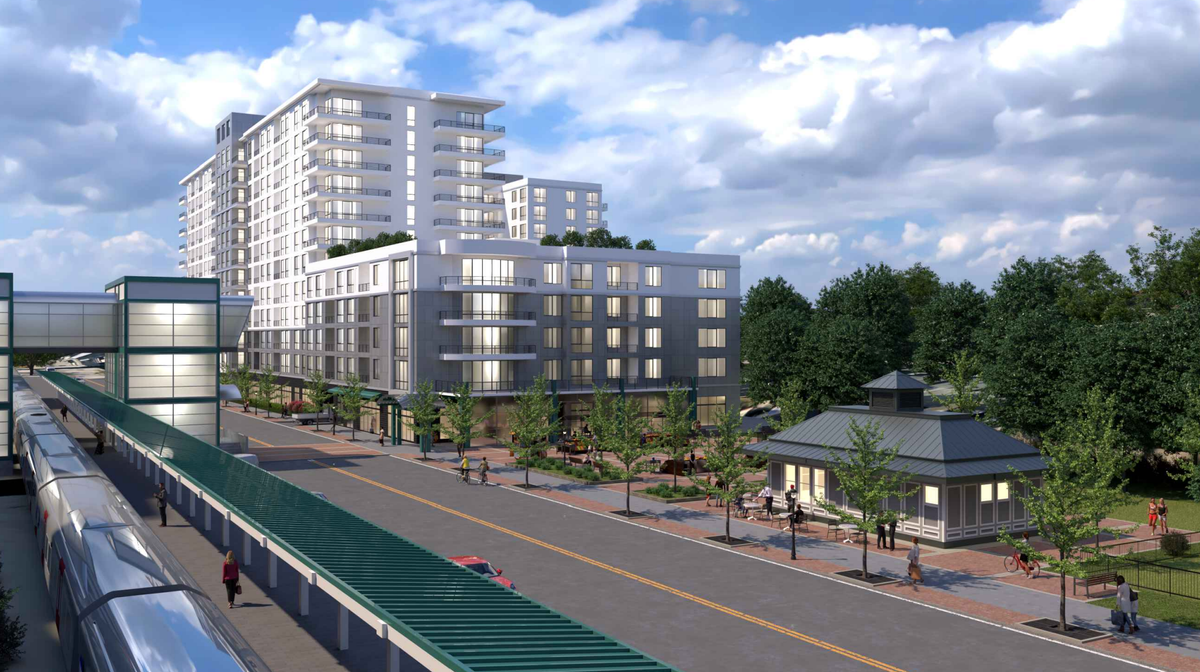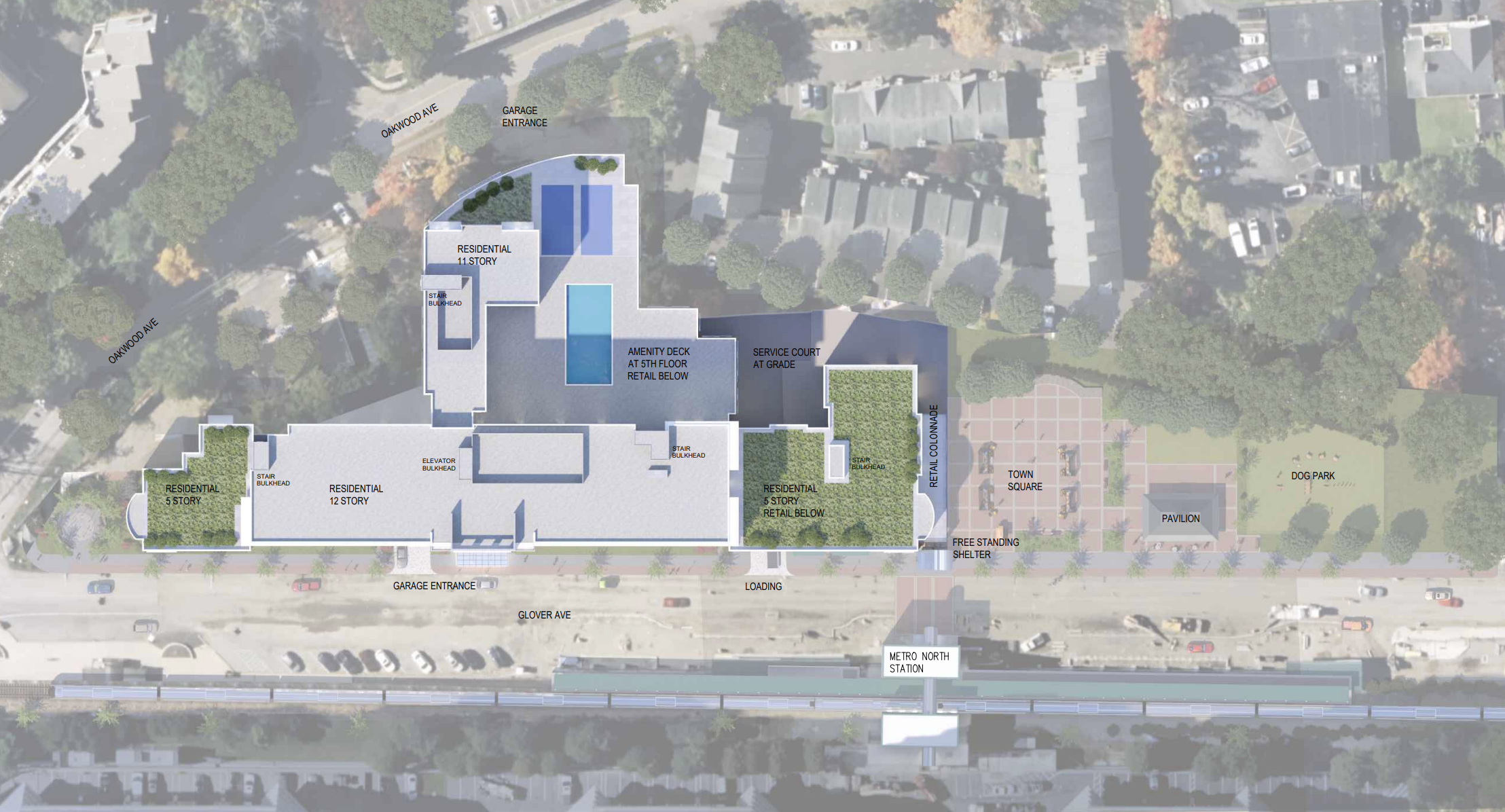Future of North Seven Plans Uncertain After Developer Pulls Application
What will happen to the area around the Merritt 7 train station in Norwalk? That's now a little bit more of a question after developer BLT pulled its Phase 1 plans.

This piece is published in partnership with NancyonNorwalk.
Despite years of planning and discussion, the future of the proposed North Seven development is suddenly up in the air after developer Building and Land Technology pulled its application for Phase 1.
Attorney David Waters, who was representing the developer, withdrew the application during the March 20 Planning and Zoning Commission meeting after commissioners seemed likely to require Building and Land Technology (BLT) to underground the utilities in the area, something Waters said would “make the project economically not viable.”
As commissioners were discussing requiring the undergrounding of the utilities—but before any official vote was taken—Waters spoke up and said that “the applications are hereby withdrawn. There’s no need to take any further action.”
Planning and Zoning Commission Chair Lou Schulman called the withdrawal “unfortunate.”
“I don't particularly appreciate the attempt to manipulate us in this way and I think that’s what it is,” he said.
That leaves the future unclear for not just the first phase of the project—which included 266 residential units, about 8,000 square feet of retail space, a town square, and a dog park—but the entire plan for the area, which called for more than 1,200 housing units, retail, a park, and more around the newly renovated Merritt 7 train station.
The developer could come back with a revised application, they could work to sell the property, or they could sell just the rights to the construction of the project, but Steve Kleppin, the city’s director of Planning and Zoning, said that he believed this wasn’t the end of BLT’s plans.
“I think they’ve made a very considerable investment in this area,” he said. “I don’t think we’ve heard the last of them.”
Who Should Underground the Utilities?
The sticking point throughout the hearing was a suggestion from city staff that as a part of the approval, the developer would be responsible for undergrounding the utilities on the street.
Waters said early in the discussion that this was “a bit of a sore point for us because we’ve been arguing about this and arguing for this for over five years.” Waters said that when the state built the new Merritt 7 train station and redid Glover Avenue, the power lines should have been put underground at that time.
“At this point to underground the overhead utilities that currently exist would literally cost several million dollars and by our consulting engineer’s estimate, it would take about a year to do it,” Waters told the commission. “So just to be clear and this is not to be melodramatic, if this were to be a condition of approval it would make the project economically not viable.”
Waters noted that the developer was not opposed to the utilities being put underground—and in fact would support it—but they believed that they shouldn’t bear the cost.
“What we are willing to do in recognition and certainly to encourage the undergrounding of utilities, we would grant whatever easements are required in order to underground the facilities and we would grant that at no cost to the city,” he said. ”But we are unable and unwilling to undertake that ourselves.”
However, commissioners and city staff said during discussions about the application that they believed the developer should work to place the utilities underground.
“I know the threat about it killing the project, but I think we need to do what we think is best for the project, best for the neighborhood, best for the city,” Lou Schulman, chair of the commission, said. “And I think having the utilities underground responds to all three of those.”
Kleppin, the city’s director of Planning and Zoning, said that city staff also agreed with that.
“I think it also adds to the resilience—if the utilities are buried underground, they’re more likely not to be damaged in a storm,” he said.
He also noted that the commission had already acquiesced to many of the developer’s requests. For example, the application in front of the commission was a change from the original master plan, which had called for two residential buildings and more retail than the developer was currently proposing.
“From your perspective, we’ve given a lot with this—they can do 12 stories throughout the development, we’ve upped the density, we’ve changed the zoning language, we’ve changed the zoning map, you’re approving a change to the master plan before it even gets started so I think you guys have demonstrated a willingness to bend to requests,” Kleppin said.
Schulman agreed, noting that he believed the developer would be saving significant money only constructing one building instead of two as a part of phase one.
Kleppin also noted that this wouldn’t be the first time the commission required undergrounding of utilities. In fact, one of the commission’s most recent approvals—plans to build more than 200 apartments at the former YMCA site—included a requirement to underground the utilities.

Concern about the Future Plans
Still, some commissioners were extremely surprised by the decision to withdraw the application—especially since a vote had not yet taken place—and were concerned about what it meant for the future of the area.
“It’s just a shame given where we are with all this and all the work that’s gone into it and we’re talking about taxes going up and needing stuff like this [project],” Commissioner Nick Kantor said.
Commissioner Galen Wells said that she would “hate to see this project go away,” because of this dispute.
Other commissioners, though surprised, were more skeptical of the developer’s reasons.
“It would seem to me the cost would be de minimis to the cost of the whole project so I’m wondering if there’s something else going on there,” Commissioner Tammy Langalis said.
Building and Land Technology is the largest developer in nearby Stamford, constructing more than 4,000 residential units along with retail and other amenities, like dog parks, in Harbor Point. The developer has also been under scrutiny recently, after a patio deck collapsed at its Allure building in 2022 and one of its first redevelopment properties in the South End neighborhood of Stamford, the Lofts at Yale & Towne, had to be evacuated after the property began sinking in the same year.
Commissioner Ana Tabachneck raised a few concerns throughout the discussion about how the developer was changing the plans and vision for the neighborhood overall.
“I’m concerned about the direction—there are incremental, step-by-step changes that continue to take it away from the plan’s big thought out, big picture vision for the area,” she said.
What’s Next?
While the application for Phase 1 was withdrawn, and while the future of the plans are uncertain, Kleppin noted that there’s a few possibilities.
“I think something else to keep in mind, while they withdrew this particular site plan application, the master plan is still approved—the prior version’s still in effect, so if and when they decide, they’ll come back with a new application,” he said.
Kleppin emphasized that the developer has made “a very considerable investment in this area,” which is why he said he believed they “haven’t heard the last of them.”
According to city property tax records, the developer—under a variety of LLCs—has spent at least $30 million to purchase properties along Glover Avenue, from 77 Glover (which would be Phase 1) up to 201 Glover.
“I'm sure they’ll be conversations between city staff and them going forward but they have to submit a new application,” he said. “I'm assuming they’ll come forward with pretty much the same project, with a very similar request, and hopefully we’ll have some of these outstanding issues before they get in front of you guys.”
The developer also could sell the properties, or work to “sell the rights to the project”—meaning they would own the land, but someone else would construct it, he said.
Still, the withdrawal leaves a big question mark over the plans for the Merritt 7 region, which had been highlighted recently by Governor Ned Lamont, State Senator Bob Duff, and others as a great example of transit oriented development.
“We know housing has huge demands all over the state and all over our nation, and building here right next to a train station, right next to the main, square view of office space is really the right place to do it,” Duff said, according to The Hour.



